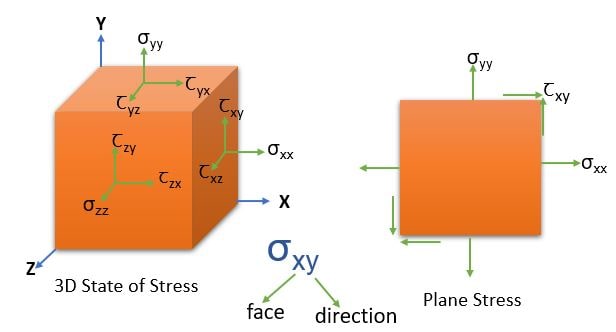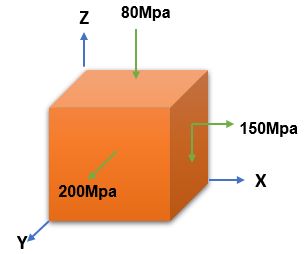 Learn Metallurgy
Learn Metallurgymail@learnmetallurgy.com
Stress Tensor is at a point is define as the state of stress at that point inside a material in the deformed state, placement, or configuration. the state of strress shows all different stress developed on 3-perpendicular plane passing through that point.
Consider a single crystal in the form of a cube subjected to a combination of normal stresses (\( \sigma_{xx}, \sigma_{yy}, \sigma_{zz} \)) and shear stresses (\( \tau_{xy},\tau_{yz},\tau_{zx} \)). The coordinate axes are chosen parallel to <100> directions if the crystal system is orthogonal (i.e., cubic, tetragonal, or orthorhombic) or to have a specified orientation with respect to the unit cell if it is not. Then the stress tensor for 3D system is given by -

Bi-axial or plane stress :
For plane stress condition any one of the mutually perpendicular faces is assumed to be zero. i.e., \( \sigma_{zz} = \tau_{zx} = \tau_{zy} = 0 \)
 The stress tensor \( \sigma_{ij} \) of the above structure is given as
The stress tensor \( \sigma_{ij} \) of the above structure is given as
Answer : 800 MPa
\( G = \frac{Shear Stress}{Shear Strain} = \frac{\tau_{xy}}{\gamma_{xy}} \)
From question \(\frac{\gamma_{xy}}{2} = 0.004 \Rightarrow \gamma_{xy} = 0.008 \)
So , \(G = \frac{\tau_{xy}}{0.008} \) As given G=100GPa
\( \Rightarrow \tau_{xy} = 800MPa \)
The total stress can be divided into a hydrostatic or mean stress tensor \( \sigma_m \), which involves only pure tension or compression , and a deviator stress tensor \( \sigma^{div}_{ij} \), which represents the shear stresses in the total state of stress. The hydrostatic component of the stress tensor produces only volume change. Such as -
\[ \textrm{Total stress } ( \sigma_{ij} ) = \textrm{Hydrostatic stress } ( \sigma_m ) + \textrm{ Deviator stress } (\sigma^{div}_{ij})\]
\[ \sigma_{ij} = \sigma_{ij}^{hydro} + \sigma_{ij}^{div} \]
\[ \begin{bmatrix}
\sigma_{11} & \tau_{12} & \tau_{13} \\
\tau_{21} & \sigma_{22} & \tau_{23}\\
\tau_{31} & \tau_{32} & \sigma_{33} \\
\end{bmatrix} =
\begin{bmatrix}
\sigma_{m} & 0 & 0 \\
0 & \sigma_{m} & 0\\
0 & 0 & \sigma_{m} \\
\end{bmatrix} + \begin{bmatrix}
\sigma_{11} - \sigma_{m} & \tau_{12} & \tau_{13} \\
\tau_{21} & \sigma_{22} - \sigma_{m} & \tau_{23}\\
\tau_{31} & \tau_{32} & \sigma_{33} - \sigma_{m} \\
\end{bmatrix} \]
\[ \textrm{ And, } \sigma_{m} = \frac{\sigma_{11} + \sigma_{22} + \sigma_{33}}{3} \]
Answer : 200 GPa
As \( K = \frac{\sigma}{e_{v}} \)
Also, \( \sigma_{hydo} = \sigma_{m} = \frac{\sigma_{11} + \sigma_{22} + \sigma_{33}}{3} = \frac{90 -20 + 140 }{3} = 70MPa \)
\( \Rightarrow K = \frac{70}{3.5 \times 10^{-4}} \)
\( \Rightarrow K = 200GPa \)